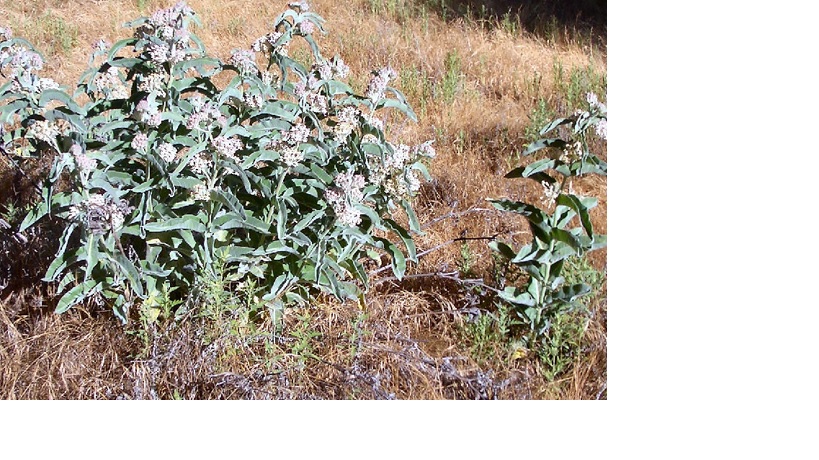

Photo credit
A native perennial herb, with large white, cream, or pinkish flowers. The leaves are large, oval, rippled along the edges, often whorled about the upright steps, and are usually covered with fine white hairs. The plant is winter deciduous and reemerges in the spring, preferring dryer soils and well-drained slopes. It produces large, woolly seed pods in late summer. Along with other milkweeds such as Narrowleaf and Showy Milkweed, Kotolo is an important host plant for the monarch butterfly caterpillar.
A.eriocarpa is found in the foothills of the northern and southern Central Valley of California, along the central coast, and in the coast ranges down into southern California and northern Baja California, Mexico. Elevation: sea level to 8,000 ft. (2500m). Sun: full or partial. Temperature: cold tolerant to 0°F (-20°C). Soil: clay, sandy, or saline; pH 6-8.
Easy to care for once established. Needs a site that is well-drained. Roots are sensitive to disturbance; avoid breaking the root ball when planting from the container. Water (.5 gallon, 2 liters) once per week until the plant drops its leaves in the first winter. Water no more than once per month, in the same amounts, in the second summer. Thereafter, no supplemental water is required.
A.eriocarpa is a host plant for the monarch butterfly's caterpillars. Milkweeds, including A.eriocarpa, contain within them an alkaloid that is mildly poisonous and distasteful to birds and other predators. However, the monarch butterfly has adapted to this distinctive plant chemistry, and its caterpillars feed on the Kotolo leaves and fine stems, absorbing the alklaoid. This makes them quite unpalatable to predators.
Aphids: Young plants especially are subject to aphids. Brush the aphids off gently by hand, with a soft brush or twig, or with a spray of water from the garden hose. Please do not use pesticides on A.eriocarpa, because these chemicals are harmful to the monarch butterfly caterpillars. California native plants are adapted to withstand the insect pests, and they don't need any chemical assistance. Also, the aphids are a prime food target for the helpful ladybug insect, so leaving a few of them on the plant conforms to an established food and life cycle.
Gophers: Can eat the roots of A.eriocarpa. If you have gophers under your site, it's probably best to plant the Woollypods with a protecting gopher screen in the ground under them.
Deer: Do not seem to browse on Kotolo.
One of the more attractive milkweeds, because of its flowers and distinctive leaves, Kotolo continues to become more popular in butterfly and pollinator gardens. Native Americans relied upon this plant for its strong fibers, making them into cords and ropes. Medicinally, it was also used as a cold remedy, a dermatological aid to reduce corns, and a respiratory aid (by inhaling dried plant smoke) for asthma.
Central Valley ecotype, 1 gallon.
San Francisco Bay Area ecotype, 1 gallon.
South Central Coast (Santa Barbara County) ecotype, 1 gallon.